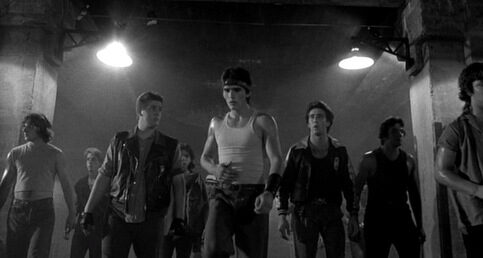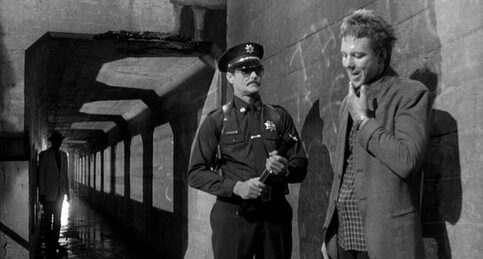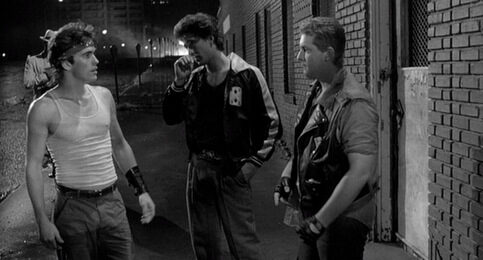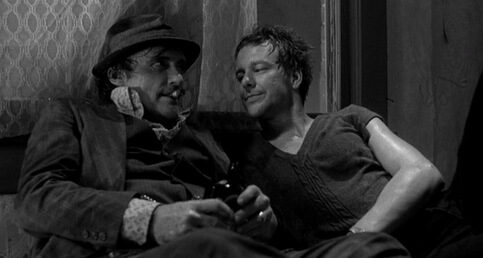Rumble Fish: Dress Code Integrity in Gang Culture |
Artily shot in black and white with occasional bursts of colour, stylised to within an inch of its life and meandering dreamily through a story of brotherly love and hero worship, Francis Ford Coppola’s Rumble Fish barely made a splash at the 1983 box office, maintains Neil Alcock.
For Coppola, Rumble Fish was, and still is, a deeply personal movie. Dedicated to his brother August, the film embodies its director’s admiration and respect for his older sibling. It’s the story of Rusty-James (Matt Dillon), a feckless, reckless gang member living in the shadow of his big brother, The Motorcycle Boy (Mickey Rourke), while simultaneously refusing to face up to impending adulthood. It’s also a film student’s dream: almost every scene is loaded with (occasionally heavy-handed) symbolism and each frame can be analysed for meaning, much of which is on full display in the film’s costume design.


Rumble Fish is based on a slim novel by S.E. Hinton which provides almost no clues as to what the characters wear, save for a brief passage in which Rusty-James observes: “I always got [The Motorcycle Boy’s] clothes when he outgrew them, but they never looked the same on me.” On the surface it’s a pointed rebuttal of Polonius’ claim in Hamlet that “clothes make the man” (Rusty-James has far more to do than dress like his brother in order to be like him), but it’s also fair to assume that this sentiment led Coppola and costume designer Marjorie Bowers to make some interesting decisions about their leads’ outfits.
Rusty-James spends much of the film in his ‘uniform’ of rebellion: his tight white vest, black leather jacket, bandana, low-slung khaki trousers and leather cuff suggesting someone trying too hard to look like trouble. But it’s in comparison to the clothes of his brother and father that Rusty-James’ outfit speaks of family, destiny and inevitability.


Rusty-James’ brother and idol, The Motorcycle Boy, wanders through the film in a v-neck cable sweater vest, occasionally covered by a two-button tweed sports jacket – with the collar upturned, naturally. The sweater feels like a grown-up version of the youngster’s vest: an evolution in the uniform of rebellion which echoes the characters’ relationship. This line from younger to older brother can be drawn further when their alcoholic father (Dennis Hopper) turns up in a trilby, rumpled striped suit with waistcoat and open-necked shirt. As a logical progression from Rourke’s sweater and jacket, Hopper’s costume provides a warning to his sons and a subtle signifier to the audience of what may lie in the boys’ future.
Of course Coppola and Bowers don’t limit their careful costume design to the lead actors; there’s plenty going on in the clothing of the supporting cast too. Rusty-James belongs to a gang, but they’re a fairly loose collective. There’s no gang uniform; each member dresses individually, both highlighting the inherent incohesion which will eventually split the gang apart and allowing the audience to easily differentiate between members. In fact in the film’s one big gang fight, Rusty-James’ nemeses are all similarly (and bizarrely) dressed in suits. The jarring choice of costume design here almost forces us to ask what Rusty-James is fighting against in this scene: a rival gang or the notion of adulthood, with all the conformity that wearing a suit implies.


A young Nicolas Cage, as Rusty-James’ lieutenant Smokey, gets one of the film’s standout items of clothing: a black satin jacket with a large playing card – the two of diamonds – embroidered on the breast, and the words “Wild Deuces” across the back. Coppola reveals in the DVD commentary that the jacket actually belonged to his brother August (also Cage’s father), linking the film’s aesthetic further to the familial bond which inspired it.
Laurence Fishburne, who plays Midget, sports an oversized off-white suit jacket with shawl lapels, dark trousers, braces, a skinny tie and Panama hat. Coppola says he saw Midget’s character as that of a guardian angel, and it’s not hard to see that in his costume design, particularly the halo-esque head wear.


Meanwhile, Steve (Vincent Spano) – Rusty-James’ bookish, teetotal best friend who’d rather be revising than fighting – conveys Ivy League innocence in an all-white outfit which includes a short-sleeved shirt tucked into slacks. Close shots reveal thin stripes on the shirt, hinting at a corruption of purity to come later in the film, and when Steve gets roaringly drunk one night his prim and austere outfit becomes as debased as he does: the sleeves are rolled up, the buttons undone and his spotless shirt stained with alcohol, vomit and blood.
It’s in the same scene – in which Rusty-James, Steve and The Motorcycle Boy visit what Coppola calls ‘the black neighbourhood’ – that costume defines the boys’ lives further. The blocks of shades of grey that make up the muted colour palette of their clothes are contrasted with a maelstrom of stripes, checks, paisley, sequins and the odd military uniform worn by the inhabitants of the black neighbourhood, who seem to enjoy a booze-fuelled whale of a time in comparison to the protagonists’ humdrum existence.


Eventually the gang begins to fall apart as its various members start to accept the inevitable onset of adulthood. Rusty-James’ girlfriend Patty (Diane Lane) substitutes her school uniform for a long, dark dress with soft flower print as she cuts him loose and starts dating Smokey, whose Wild Deuces jacket has been hung up and replaced by a much less wild white shirt (though is glimpsed one last time in the penultimate scene of the story implying a still deep rooted affinity with Rusty). The uniforms of rebellion give way to uniforms of responsibility, and only Rusty-James, still in the white vest in which he began the film, refuses to accept that responsibility.
Rumble Fish may not be the most subtle of films, and its deliberately stylised look isn’t for everyone. It is, however, a noteworthy entry in the canon of a masterful director, and a useful example of how costume design can be employed to reinforce character and plot.
By Neil Alcock. Neil is a regular contributor to Empire magazine. Read film reviews and musings at his witty and essential blog The Incredible Suit.
Rumble Fish was released on Criterion Collection Blu-ray on 27th August.
© 2012, Contributor.
